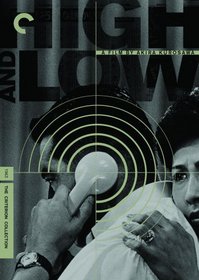| Actors: Toshirô Mifune, Tatsuya Nakadai, Kyôko Kagawa, Takashi Shimura, Tsutomu Yamazaki Director: Akira Kurosawa Creators: Takao Saitô, Choichi Nakai Genres: Indie & Art House, Drama, Mystery & Suspense Sub-Genres: Indie & Art House, Family Life, Mystery & Suspense Studio: Criterion Format: DVD - Black and White,Widescreen - Subtitled DVD Release Date: 07/22/2008 Original Release Date: 01/01/1963 Theatrical Release Date: 00/00/1963 Release Year: 2008 Run Time: 2hr 23min Screens: Black and White,Widescreen Number of Discs: 2 SwapaDVD Credits: 2 Total Copies: 0 Members Wishing: 16 Edition: Special Edition,Criterion Collection MPAA Rating: Unrated Languages: Japanese Subtitles: English See Also: |
Search - High and Low - (The Criterion Collection) on DVD
  | High and Low The Criterion Collection Actors: Toshirô Mifune, Tatsuya Nakadai, Kyôko Kagawa, Takashi Shimura, Tsutomu Yamazaki Director: Akira Kurosawa Genres: Indie & Art House, Drama, Mystery & Suspense UR 2008 2hr 23min Although best known for his samurai classics, Japanese master filmmaker Akira Kurosawa proved himself equally adept at contemporary dramas and thrillers, and 1962's High and Low offers a powerful showcase for Kurosawa's ve... more » |
Larger Image |
Movie DetailsSimilar Movies
|
Movie ReviewsNOT one of Akira Kurosawa's best; perhaps most copied. Rev. E. A. Hernandez | 05/25/2009 (4 out of 5 stars) "All the excellent details and workings of this film are explained in the other reviews here, and very beautifully at that. Trouble with this film is that it is clearly not one of Kurosawa's finest of all the oeuvre d'art he has given us. I like to think and evaluate for myself, so to hell with "Kurosawa scholars". This is a critique.
Kurosawa's wife once complained of how miserable life was with him at home when he wasn't working. This 1962 film shows the possibility that Kurosawa made it in order to escape ennui and his wife's wrath. Its opening scenes are certainly super-Oscar-worthy, with the tension of the expectant Gondo-san hovering near the telephone, awaiting the kidnapper's next call. And the smooth, perfectly acted relationship between all the characters who come to be involved is Kurosawa at his best. He follows with Hitchcockian shots and brilliant angles on Tokyo's Bullet train... I have no doubt Hitchcock envied those scenes. From the train, Gondo-san is to throw the two briefcases containing the ransom money. The police, with Gondo-san's help, have planted pink smoke bombs in the cases in the event the kidnapper attempts to burn them later... which he does, and in the midst of Kurosawa's usual black-and-white splendor rises deep pink smoke from one of Tokyo's garbage dump furnaces. Spielberg was so captivated by that scene he used it to great effect in "Schindler's List". And this brings us to the film being Kurosawa's most inspiring. Everything from "Dragnet" [following the brilliant cops as they dredge through evidence] to "Gone Baby Gone" [a horribly loused-up kidnapping scheme] seems to take from this film. A creepy shot with the kidnapper wearing his trademark sunglasses at night was scene copied in "Sin City" by Elijah Woods' character Kevin the psychopath. The trouble is that nearly a quarter of "High and Low" seems senseless, random filming in the busy night-time streets Of Tokyo. It seemed refreshing at first, but to drag it out as Kurosawa did seems totally pointless, and it is this nonsense that made the film go well over two hours' running time. The end is also so silly that it could not fail to be copied in every film with a prison-visit scene. Why does Gondo-san waste time visiting and listening to the ranting kidnapper in jail? What exactly is the kidnapper on, what is he all about? The trite answer of prosperity-versus-poverty is sickeningly thin. Kurosawa knew how to end films with a bang... and here he utterly fails. I can only say that I too was deeply moved by Mifune's deep, beautiful performance. I've never seen him act so well, great actor that he was, and I've seen almost everything he's ever done. In this film, he reminded me, for the first time, of my own father who was an auto mechanic/engineer, and my uncle, who was a cobbler/leathersmith. And by the way, it is true that in the old days cobblers were competent leathersmiths who made everything. The scene with Gondo-san re-working the Mexican-style briefcases reminded me of my uncle, who made belts and holsters for the Chicago PD for decades. See this film, own it as it is rarely mentioned in Kurosawa's best and for good reason, but buy it anyway. The tension, the modernity which gave birth to American crime-themed television, the too-few iconic shots that have been copied ever since... it's all worth it. Just recall, this in my opinion is N O T one of Kurosawa's strongest moments. For that, see ''Kagemusha'' or ''Dersu Uzala''." |






